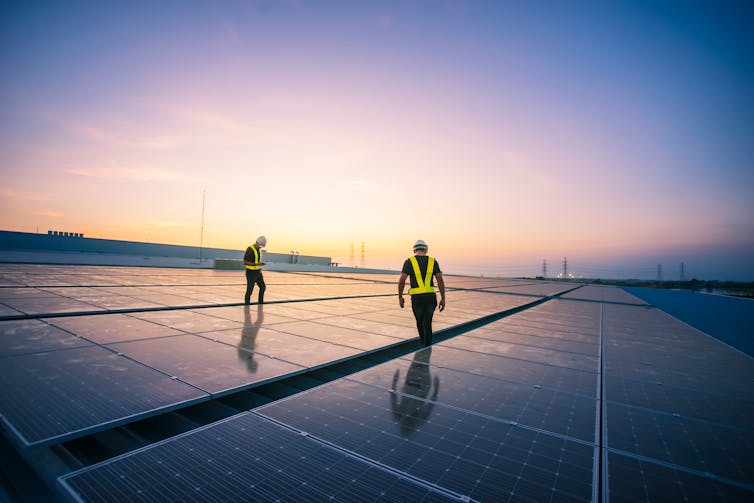What long-term stagnation of global economy means for climate change
The financial shock the UK has recently suffered is of course bad for green investment. The Rishi Sunak-led government is also likely to use this crisis to push for further public spending cuts that will rule out a truly transformative green agenda.
However, in my recent academic paper I argue that the economic obstacles to effective decarbonisation are more deeply entrenched than that. We can’t simply blame a bad government budget or even the global market turmoil sparked by Russia’s invasion of Ukraine.
Instead, the global economy has been trapped in a state of relative stagnation in rates of growth, productivity, investment and profitability since at least the 2008 financial crisis, with some scholars even dating the onset of the malaise to the 1970s. This so-called secular stagnation is a global trend, but the UK has performed particularly poorly.
This represents a colossal problem for mainstream visions of decarbonisation. Most states, business groups and international organisations believe it must be driven by a tremendous global boom in private investment in renewable energy and sustainable infrastructure – estimates range from US$4.4 trillion a year until 2050 up to $9.2 trillion a year.
In this view, the role of states is to shepherd investors away from “brown” fossil fuel assets and towards green ones. The problem with this “green growth” vision is that for decades it has proven very difficult for states to generate any global, sustained boom in private investment – whether green or brown.
There is no consensus on the causes of this long-term stagnation, with different scholars pointing to slowing population growth, anti-labour policy agendas, or industrial overproduction. Yet what is clear is that stagnation acts as a fundamental drag on efforts to green the world economy. A few examples can illustrate this.
Steel and solar
The steel industry is a key driver of climate change and is responsible for around 7% to 9% of global carbon emissions. Currently, many steel plants burn coke to heat their blast furnaces, releasing carbon dioxide in the process. There are several ways to green this process, with perhaps the most plausible involving the use of green hydrogen and electric arc furnaces.
The problem is that these green solutions are expensive, in an industry that is already wracked by overproduction and weak profitability. Reorganising production and retooling factories worldwide would require firms to make massive investments, but glutted steel markets mean that such investments would be unlikely to yield high returns. The stagnant state of the industry therefore militates against its rapid decarbonisation.

At first glance, solar power looks like the polar opposite of an old, heavy industry like steel. The production of solar panels is literally a sunrise industry: from the early 2000s, when generous renewable energy subsidies were introduced in Europe, investment has flooded in and generated a boom.
And yet there are signs that this industry too is increasingly hampered by chronic overcapacity and vanishing profitability. As production has become increasingly concentrated in China, where it is most cost-effective, the industry has been transformed by automation and massive economies of scale.
It now resembles a typical commodities business with a high output of standardised products, and low prices and profits. As The Economist recently labelled the industry: “Good for the planet – but hardly a gold mine”. Many solar firms have gone bankrupt or simply abandoned the sector.
There has yet to be a grinding slowdown in solar panel production in response to these weak profits, partly due to massive subsidies in China.
Democratising decarbonisation
These dynamics can be found across many sectors that require urgent decarbonisation, from industry to energy to transport. For those who think climate change can only be resolved by markets and private investors, it’s an existential threat to their worldview. Yet the stagnation doesn’t actually show that decarbonisation is impossible, rather that it will be difficult to do so by capitalist means.

For this reason, it is important to take seriously radical visions of decarbonisation that involve using collective ownership and democratic economic planning to rapidly expand renewable infrastructure. Faced with an unprecedented environmental catastrophe and the inertia of private markets, why should key industries like steel or solar be run according to the principle of profit maximisation instead of climate stability?
Run in a collective and democratic manner, the production of solar panels could be carefully managed to address a range of social concerns, from meeting carbon emissions goals to protecting communities where quartz mining is located to ensuring fair working practices in silicon factories. Deliberation between stakeholders would replace the blind imperative of money making.
![]()
While similar proposals can be found in some strands of green new deal and degrowth thought, these measures remain marginal to the broader debate on decarbonisation. Such a radical departure from contemporary economic orthodoxy is unlikely to be adopted by governments unless they are pushed by powerful social movements. Building such movements is the challenge of our time.![]()
Jack Copley, Assistant Professor in International Political Economy, Durham University
This article is republished from The Conversation under a Creative Commons license. Read the original article.
![]()
For all the latest Business News Click Here
For the latest news and updates, follow us on Google News.
